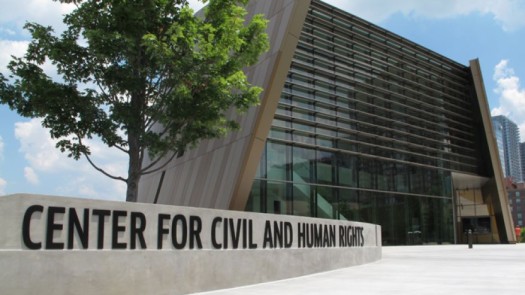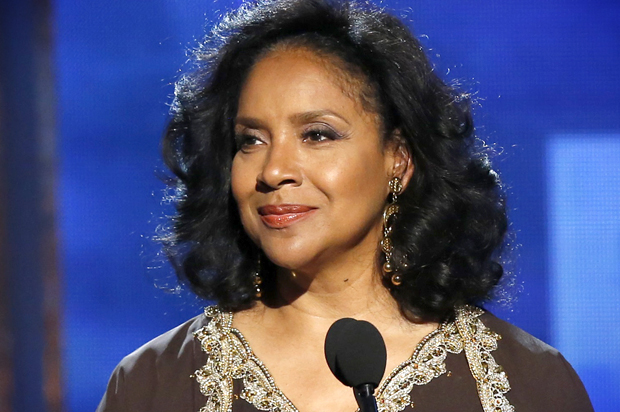
After nine years of strategic planning and construction, downtown Atlanta’s Center for Civil and Human Rights (CCHR) opened its doors to the public this past Jun. 23. The museum’s immense three-level, 42,000-square-foot interior chronicles in great detail how the African American struggle towards equality ignited global movements and activism towards social change.
The voyage begins with a cyclical Civil Rights menagerie on the main level. Conceived by Tony-winning Broadway veteran and CCHR’s Chief Creative Officer George C. Wolfe, despair echoes through the ambiance of pivotal moments like the Freedom Riders, the March on Washington, the Birmingham church bombing where four little girls were killed and Dr. Martin Luther King, Jr.’s funeral.
Wolfe, synonymous with providing extraordinary direction for both stage and screen, stylizes tear jerking exhibitions room-by-room in a way that marries stage production with docudrama. A medley of somber lighting, black-and-white news footage, maps, quotes, photo collages, listening stations and basic props illustrate a nostalgic sentiment.
The serial time capsule is a tangible lesson in American history. “I grew up in rural Arkansas and was born after the movement, so I don’t remember the stories of the Civil Rights Movement,” says CCHR CEO Doug Shipman, who has served as CEO since the Center’s inception.
“Everything takes and transforms you there. Those moments are meaningful to me.”
CCHR’s architect Phil Freelon, who also co-designed the Smithsonian National Museum of African American History and Culture, remembers his parents participating in the movement throughout the 1950s and 60s.
The museum’s interlocked arm-styled exterior, he says, suggests diverse people uniting. “Every project is different in terms of content, context, mission and vision of the institution,” says Freelon immediately following CCHR’s grand opening ceremony.
“By definition, it’s its own special place, and we wanted to express that in architectural form.”
Dressed in a well-tailored golden tan suit, the modest, salt-and-pepper-haired Freelon expounds upon CCHR being composed primarily of windows. He is honored to have assisted with the development of the commemorative attraction.
“It’s been a very long process and years in the making,” says Freelon. “We wanted it to be a welcoming experience. The notion that it’s open for everyone was really important to us even before they see the exhibits.”
At the twist of a knob, replicas of vintage analog television sets broadcast various white segregationists unapologetically verbalizing their hatred towards blacks. Striking footage of riots and disillusioned protestors provide subsequent imagery. Mug shots and headlining news print are also tiled and plastered across every wall.
A rotating marquee lists Jim Crow laws by each state. The lunch counter simulator revisits sit-ins with handprints across the counter, digital timers in front of each stool and headphones that playback catcalls, threats and racial epithets.
Located on the same 20-acre grounds as the World of Coca-Cola and Georgia Aquarium, CCHR’s galleries, which will rotate three times annually, should encourage visitors to look within themselves and take a stand towards protecting the rights of all people despite their differences.
The idea for CCHR originally stemmed from late civil rights activist Evelyn Lowery and Ambassador Andrew Young but was spearheaded by former mayor Shirley Franklin. Freelon, on the other hand, speaks about how planning out the project’s functional elements and allocating the necessary space to accommodate visitors required extensive teamwork.
“Collaborators help bring focus to it,” says Freelon now seated under a tent to dodge the heat. “Certain forces play into it. It’s not just pure art.”
The global human rights component, curated by Jill Savitt, is what sets CCHR apart from other American cultural centers and historic museums. Photographer Platon created a colorful, wall-sized mural on the main level with slices of political protests from around the world.
The mural’s sibling black-and-white photograph on the level above combines 10 photos of diverse ethnic activists. The color white completely blankets the walls as the Civil Rights exhibit morphs into human rights.
The human rights installation actively employs more technology. Slanted walls and ceilings covered with massive high definition monitors stream recurring devastating images of injustice across the globe.
Its adjacent “I AM” station has touchscreen mirrors that stream diverse members of the world community delivering brief testimonials on how they each experienced discrimination and brutal treatment on the basis of gender, ethnicity, sexuality, religion, age or career.
Wood plaques with etched quotes and portrait-like paintings cover the remainder of the walls. Illuminated blocks with lifesize photos of various ethnic people are positioned across the floor. A glass case mounts images of dictators in their real height. Displays of consumer soccer balls, athletic sneakers and chocolate give further insights on child labor abuses.
The bottom level Dr. King Collection, in partnership with Morehouse College, rounds out the journey. The tranquil shrine displays artifacts such as King’s handwritten (and typed) notes and belongings. King’s documents will be alternated every four months for preservation.
A mural of the famed orator’s library sits parallel to tiled high definition monitors with “I Have a Dream” crawling horizontally in over 20 languages. Outside the room sits a dangling tiled mobile photograph of Dr. King.
That’s the area that strikes a chord directly with Shipman, who obtained one of his master’s degrees from Harvard Divinity School.
“Seeing King’s papers on a daily basis and his handwriting is extremely impactful,” says an upbeat Shipman. “Each individual will have a very personalized experience. We give them opportunities to think about issues they’ve never thought about before,” added the CEO.
At the grand opening, Civil Rights leaders like Young, Rep. John Lewis (D-GA) and Xernona Clayton attended. Both the brother of slain advocate Andrew Goodman and daughter of slain Michigan activist Viola Liuzzo appeared. Relatives of Dr. King and the Four Little Girls were also special guests.
Community organizations, youth programs, civic leaders, city council members and Atlanta citizens composed the remainder of the audience. Following a massive confetti explosion and angelic choral selections, Shipman, Franklin, Wolfe, Young and Freelon were flanked with requests to take pictures, give hugs and handshakes.
The morning is an indication, according to Shipman, that CCHR is a vital addition to the American fabric. “It was incredible today,” says Shipman immediately following a slew of interviews. “We had icons and relatives. To have them come and say this is important and a wonderful memorial for their families is incredibly moving.”
This post was written by Christopher A. Daniel, pop cultural critic and music editor for The Burton Wire. He is also a contributing writer for Urban Lux Magazine and Blues & Soul Magazine. Follow Christopher @Journalistorian on Twitter.
Like The Burton Wire on Facebook. Follow us on Twitter @TheBurtonWire.








